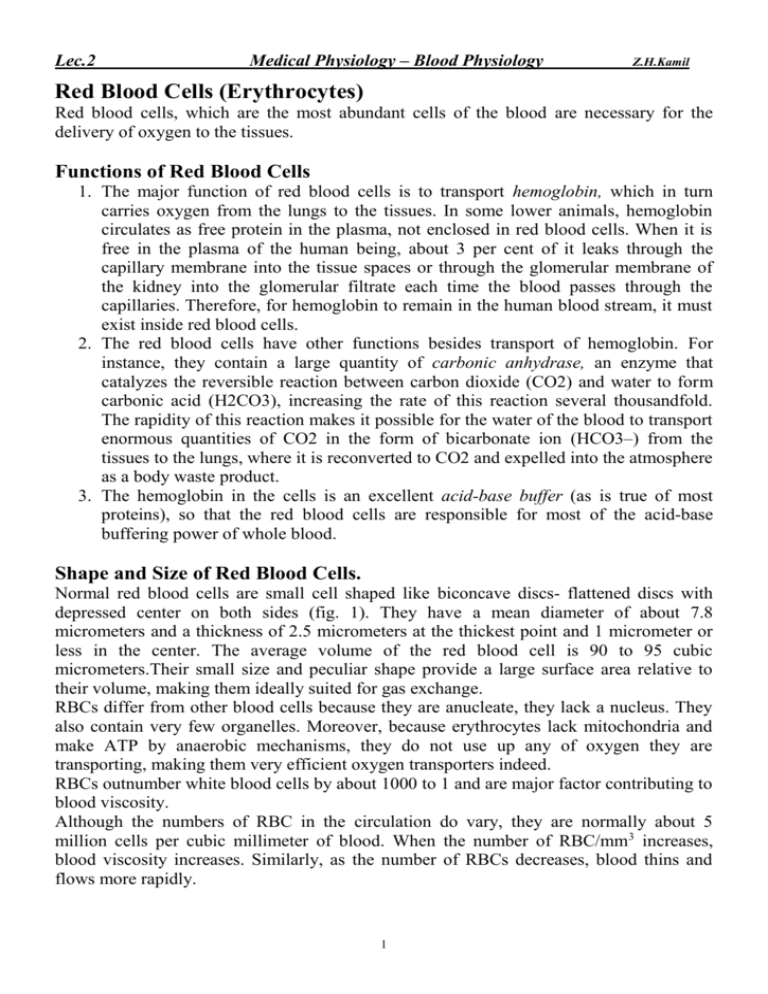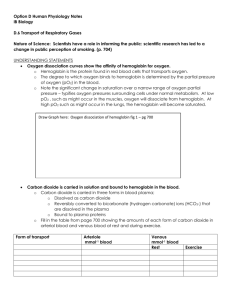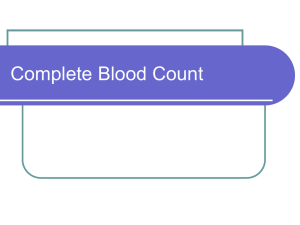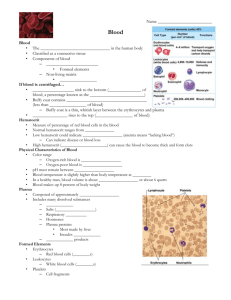Red Blood Cells (Erythrocytes)
advertisement

Lec.2 Medical Physiology – Blood Physiology Z.H.Kamil Red Blood Cells (Erythrocytes) Red blood cells, which are the most abundant cells of the blood are necessary for the delivery of oxygen to the tissues. Functions of Red Blood Cells 1. The major function of red blood cells is to transport hemoglobin, which in turn carries oxygen from the lungs to the tissues. In some lower animals, hemoglobin circulates as free protein in the plasma, not enclosed in red blood cells. When it is free in the plasma of the human being, about 3 per cent of it leaks through the capillary membrane into the tissue spaces or through the glomerular membrane of the kidney into the glomerular filtrate each time the blood passes through the capillaries. Therefore, for hemoglobin to remain in the human blood stream, it must exist inside red blood cells. 2. The red blood cells have other functions besides transport of hemoglobin. For instance, they contain a large quantity of carbonic anhydrase, an enzyme that catalyzes the reversible reaction between carbon dioxide (CO2) and water to form carbonic acid (H2CO3), increasing the rate of this reaction several thousandfold. The rapidity of this reaction makes it possible for the water of the blood to transport enormous quantities of CO2 in the form of bicarbonate ion (HCO3–) from the tissues to the lungs, where it is reconverted to CO2 and expelled into the atmosphere as a body waste product. 3. The hemoglobin in the cells is an excellent acid-base buffer (as is true of most proteins), so that the red blood cells are responsible for most of the acid-base buffering power of whole blood. Shape and Size of Red Blood Cells. Normal red blood cells are small cell shaped like biconcave discs- flattened discs with depressed center on both sides (fig. 1). They have a mean diameter of about 7.8 micrometers and a thickness of 2.5 micrometers at the thickest point and 1 micrometer or less in the center. The average volume of the red blood cell is 90 to 95 cubic micrometers.Their small size and peculiar shape provide a large surface area relative to their volume, making them ideally suited for gas exchange. RBCs differ from other blood cells because they are anucleate, they lack a nucleus. They also contain very few organelles. Moreover, because erythrocytes lack mitochondria and make ATP by anaerobic mechanisms, they do not use up any of oxygen they are transporting, making them very efficient oxygen transporters indeed. RBCs outnumber white blood cells by about 1000 to 1 and are major factor contributing to blood viscosity. Although the numbers of RBC in the circulation do vary, they are normally about 5 million cells per cubic millimeter of blood. When the number of RBC/mm3 increases, blood viscosity increases. Similarly, as the number of RBCs decreases, blood thins and flows more rapidly. 1 The shapes of red blood cells can change remarkably as the cells squeeze through capillaries. Actually, the red blood cell is a “bag” that can be deformed into almost any shape. Furthermore, because the normal cell has a great excess of cell membrane for the quantity of material inside, deformation does not stretch the membrane greatly and, consequently, does not rupture the cell, as would be the case with many other cells. Concentration of Red Blood Cells in the Blood. In normal men, the average number of red blood cells per cubic millimeter is 5,200,000 (±300,000); in normal women, it is 4,700,000 (±300,000). Persons living at high altitudes have greater numbers of red blood cells. The more hemoglobin molecules RBCs contain, the more oxygen they will be able to carry, so the most accurate way of measuring the oxygen-carrying capacity of the blood is to determine how much hemoglobin it contains. Although the numbers of of erythrocytes are important, it is the amount of hemoglobin in the blood stream at any time that really determines how well the erythrocytes are performing their role of oxygen transport. Since a single RBC contains about 250 million hemoglobin molecules, each capable of binding 4 molecules of oxygen, each of these tiny cells can carry about 1 billion molecules of oxygen. Quantity of Hemoglobin in the Cells. Red blood cells have the ability to concentrate hemoglobin in the cell fluid up to about 34 grams in each 100 milliliters of cells. Hemoglobin (Hb), an iron binding protein, transports the bulk of the oxygen that is carried in the blood. It is also binds with a small amounts of carbon dioxide. Normally blood contains 12-18 g hemoglobin per ml blood. The hemoglobin content is slightly higher in men (13-18 g) than in women (12-16 g). Figure (1): Normal erythrocyte 2 Production of Red Blood Cells [Erythropoiesis] Erythrocyte development is divided into several stages and at each stage the cell will divide several times. As bone marrow does not act as storage, all erythrocytes produced are immediately released into the circulation. A- Areas of the Body that produce RBCs In the early weeks of embryonic life, primitive, nucleated red blood cells are produced in the yolk sac. During the middle trimester of gestation, the liver is the main organ for production of red blood cells, but reasonable numbers are also produced in the spleen and lymph nodes. Then, during the last month or so of gestation and after birth, red blood cells are produced exclusively in the bone marrow. B- Genesis of Blood Cells Stem cell Stem cells give rise to precursors which eventually mature to form the fully developed erythrocyte. Initially, the multipotential myeloid stem cell (CFU-GEMM) differentiates into the erythroid CFU (CFU-E). This develops into the first erythrocyte precursor, the proerythroblast. The development process is controlled and influenced by a number of different factors including erythropoietin, IL-3, IL-4 and granulocyte-macrophage colony stimulating factor (GM-CSF). Growth and Differentiation Inducers Growth and reproduction of the different stem cells are controlled by multiple proteins called growth inducers. Four major growth inducers have been described, each having different characteristics. One of these, interleukin-3, promotes growth and reproduction of virtually all the different types of committed stem cells, whereas the others induce growth of only specific types of cells. The growth inducers promote growth but not differentiation of the cells.This is the function of another set of proteins called differentiation inducers. Each of these causes one type of committed stem cell to differentiate one or more steps toward a final adult blood cell. Formation of the growth inducers and differentiation inducers is itself controlled by factors outside the bone marrow. For instance, in the case of erythrocytes (red blood cells), exposure of the blood to low oxygen for a long time results in growth induction, differentiation, and production of greatly increased numbers of erythrocytes. C- Stages of Development (Differentiation) of RBCs : Erythropoiesis pathway The naming of the stages of the erythrocyte precursors varies. The main headings for this section refer to each stage in terms of a histological description, namely the proerythroblast, basophilic erythroblast, polychromatic erythroblast, orthochromatic erythroblast and polychromatophilic erythrocyte (fig. 2) 3 Proerythroblast The first erythrocyte precursor produced directly from the CFU-GEMM (multipotential myeloid stem cell, forming granulocytes, erythroblasts, macrophages and megakaryocytes) under the influence of erythropoietin. It has a large nucleus with free ribosomes in the cytoplasm giving the cytoplasm a basophilic appearance. Basophilic erythroblast Smaller than the proerythroblast with a smaller nucleus but a more basophilic cytoplasm due to increased numbers of ribosomes in the cytoplasm. These ribosomes are involved in the production of haemoglobin. Polychromatic erythroblast This is the last precursor cell capable of mitosis and is smaller than the basophilic erythroblast. Its cytoplasm appears greyer due to the increased acidophilic staining caused by the presence of haemoglobin. Orthochromatic erythroblast Also called a normoblast. It is incapable of cell division and is only slightly larger than a mature erythrocyte but it does contain a small dense nucleus. Polychromatophilic erythrocyte Also called a reticulocyte and is formed when the nucleus is extruded from the normoblast. It still contains some ribosomes and therefore retains a slight basophilic stain. The clustering of the ribosomes forms a reticular network giving the name, reticulocyte. These cells can carry oxygen and enter the blood stream and are found in low concentrations in normal blood. Erythrocyte Commonly called the red blood cell. It is the final product of erythropoiesis and is released from the bone marrow into circulation. D- Regulation of RBCs Production The rate of erythrocyte production is controlled by a hormone called erythropoietin. Normally a small amount of erythropoietin circulates in the blood at all times, and RBCs are formed at a fairly constant rate. Although the liver produced some, the kidneys play the major role in producing this hormone. When blood levels of oxygen being to decline for any reason, the kidneys set up their release of erythropoietin (fig.3). Erythropoietin targets the bone marrow, prodding it into "high gear" to turn out more RBCs. An overabundance of erythrocytes, or an excessive amount of oxygen in the blood stream, depresses erythropoietin release and RBC production. An important point to remember is that it is not the relative number of RBCs in the blood that controls RBC production. Control is based on their ability to transport enough oxygen to meet the body's demands. 4 Figure (2): Stages of RBC genesis 5 Figure (3): Regulation of RBCs production E- Requirements for Maturation of RBCs Because of the continuing need to replenish red blood cells, the erythropoietic cells of the bone marrow are among the most rapidly growing and reproducing cells in the entire body. Therefore, as would be expected, their maturation and rate of production are affected greatly by a person’s nutritional status. Especially important for final maturation of the red blood cells are two vitamins, vitamin B12 and folic acid. Both of these are essential for the synthesis of DNA, because each in a different way is required for the formation of thymidine triphosphate, one of the essential building blocks of DNA. Therefore, lack of either vitamin B12 or folic acid causes abnormal and diminished DNA and, consequently, failure of nuclear maturation and cell division. Furthermore, the erythroblastic cells of the bone marrow, in addition to failing to proliferate rapidly, produce mainly larger than normal red cells called macrocytes, and the cell itself has a flimsy membrane and is often irregular, large, and oval instead of the usual biconcave disc. These poorly formed cells, after entering the circulating blood, are capable of carrying oxygen normally, but their fragility causes them to have a short life, one half to one third normal.Therefore, it is said that deficiency of either vitamin B 12 or folic acid causes maturation failure in the process of erythropoiesis. 6 Formation of Hemoglobin Synthesis of hemoglobin begins in the proerythroblasts and continues even into the reticulocyte stage of the red blood cells. Therefore, when reticulocytes leave the bone marrow and pass into the blood stream, they continue to form minute quantities of hemoglobin for another day or so until they become mature erythrocytes. Figure 4 shows the basic chemical steps in the formation of hemoglobin. First, succinyl-CoA, formed in the Krebs metabolic cycle, binds with glycine to form a pyrrole molecule. In turn, four pyrroles combine to form protoporphyrin IX, which then combines with iron to form the heme molecule. Finally, each heme molecule combines with a long polypeptide chain, a globin synthesized by ribosomes, forming a subunit of hemoglobin called a hemoglobin chain (Figure 5). Each chain has a molecular weight of about 16,000; four of these in turn bind together loosely to form the whole hemoglobin molecule. There are several slight variations in the different subunit hemoglobin chains, depending on the amino acid composition of the polypeptide portion. The different types of chains are designated alpha chains, beta chains, gamma chains, and delta chains. Figure (4) : Formation of Hemoglobin 7 Figure (5) : Structure of Hemoglobin Types of Hemoglobin 1. Hemoglobin A: is a combination of two alpha chains and two of beta chains, it is the most common form of hemoglobin (95-98%) in the adult human being. 2. Hemoglobin A2: is a combination of two alpha chains and two of delta chains, it represents 2-3% of hemoglobin in the adult human being. 3. Hemoglobin F (fetus Hb): is a combination of two alpha chains and two of gamma chains, also it found in newborns blood of about 1% of their hemoglobin. Because each hemoglobin chain has a heme prosthetic group containing an atom of iron, and because there are four hemoglobin chains in each hemoglobin molecule, one finds four iron atoms in each hemoglobin molecule; each of these can bind loosely with one molecule of oxygen, making a total of four molecules of oxygen (or eight oxygen atoms) that can be transported by each hemoglobin molecule. The types of hemoglobin chains in the hemoglobin molecule determine the binding affinity of the hemoglobin for oxygen. Abnormalities of the chains can alter the physical characteristics of the hemoglobin molecule as well. For instance, in sickle cell anemia, the amino acid valine is substituted for glutamic acid at one point in each of the two beta chains. When this type of hemoglobin is exposed to low oxygen, it forms elongated crystals inside the red blood cells that are sometimes 15 micrometers in length. These make it almost impossible for the cells to pass through many small capillaries, and the spiked ends of the crystals are likely to rupture the cell membranes, leading to sickle cell anemia. 8








